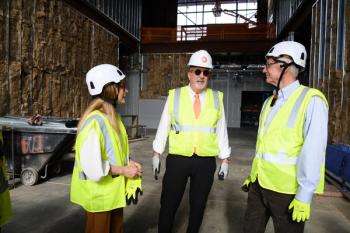
How to teach a lab new tricks
This area is often a forgotten space in your hospital, but highly-trained team members spend a lot of time working in this space. Putting thought into its design will foster better patient care and staff efficiency.
In the lab space at Woodhaven Veterinary Clinic, Edmonds, Washington, the microscope is placed toward the outside of their space to keep it from being jostled by the other equipement. Photo courtesy of Tim Murphy, Foto Imagery.
The laboratory is a relatively low-drama space. There aren't animals trapesing through it, there aren't clients in eyesight or earshot. It's often the forgotten room in the hospital. Labs tend to drop off people's radar when it comes to thinking critically about the design of their facility.
And why should we think critically about the lab's design?
For starters, there are highly-trained team members that spend a great deal of time working hard in this space. These key staff are integral in assisting the rest of the clinical team in diagnosing a patient's illness and are thus keystone players in the success of the practice. Creating an ergonomic space for them-constructed with materials that will stand the test of time-will not only help with staff retention, it will also foster better patient care.
Labs are also an important profit center for the practice. Finding ways to create a well-designed, efficient space with adequate light will help produce faster and more accurate test results. This will in turn lead to the clinician's ability to diagnose and treat more quickly and effectively.
So where do we begin with the design of a laboratory?
First is the overall placement of the space or room in the hospital. In smaller practices, it's usually more efficient to place the lab in the zone between the exam rooms and the treatment area. The reason for this is three-fold:
1. In smaller facilities, the technicians and nursing staff tend to multi-task more between these two spaces.
2. Locating the laboratory in between the exam rooms and treatment provides a sound buffer between these areas. Treatment is usually the loudest space in the hospital. Using spaces like the lab (or the pharmacy) as a buffer helps to cut down on noise transfer. This plan also creates a visual barrier between the client zone to the patient zone. In these smaller practices a widened hallway or alcove space behind the exam rooms can be ideal.
3. The third reason, which we sometimes lose sight of, is that the lab should be in close proximity to where samples are being drawn. As an estimation, 85 percent of samples are coming from patients in the treatment (or ICU) area. Another 15 percent are coming from a client bringing the sample in, or the technician drawing the sample in an exam room. For efficient sample handling it is important to locate the lab near these spaces.
PetCare Veterinary Hospital in Santa Rosa, California, has open shelving and an island set up in their laboratory. Photo courtesy of Tim Murphy, Foto Imagery.
In larger hospitals, typically specialty and/or emergency service based, the lab tends to grow in terms of the types and frequency of the tests that are run. In turn, the quantity, size and sometimes even quality of the equipment grows. At this stage a dedicated room is typically required for the lab. For some of the same reasons as listed above for smaller facilities, it is important to also locate these enclosed lab rooms near the treatment core and a reasonable distance to the exam rooms.
Multi-story hospitals, or hospitals with delineated departments may require secondary or even tertiary lab spaces if a department or floor has a high demand for running timely diagnostics. There is a wide range of lab-related needs throughout any hospital.
One of the first steps in laying out a proper lab space is understanding how your unique practice functions. One facility may require three lab testing machines in a hallway space while another larger emergency facility may have an enclosed lab with many separate machines. In addition, an ICU or CCU space may have additional equipment that is used for quick tests that are run frequently in this type of setting.
Equip your space
Here's a breakdown of the most common equipment used in laboratory spaces.
> Chemistry, hematology and urine analyzers
> Centrifuge(s)
> Sink with drainboard for staining slides
> Microscope
> Refrigerator
> Incubator
In addition, there are also administrative equipment needs such as:
> Computer(s)
> Phone
> Printer(s) - which can be individually linked to each testing machine
> Label printer
The laboratory space also needs to be laid out efficiently. The easiest way to do this is to gather an equipment list of the various required machines and then lay them out by grouping the most frequently used ones together. Careful consideration should be given to the quantity of team members needed to effectively run this equipment as well as the placement of the workstations for each of these people. Whenever possible, it is best to leave an additional 20 percent of counter space above what you believe you will need when you first move into the hospital. This will allow for future growth and upgrades in equipment.
Quick tip, when possible, you should do your best to locate the centrifuge (which shakes a lot when in motion) separate from your microscopic viewing station. This is best done by allocating an island for it. If you cannot fit an island into your lab, a counter mounted at a separate height to house your microscope will suffice.
Aside from sufficient counter space for proper placement of the equipment, the next most important component to a properly laid out lab is storage, storage and more storage. Base cabinets and upper cabinets are the mainstay for testing materials, including such things as ELISA snap tests. Base cabinets are good for proper storage of such things as bottles of reagent used with larger testing machines like hematology analyzers. A variety of open upper cabinets are also handy for storage of quick reference books typically used around the microscope station as well as open adjustable shelves with power located at the back side for storage of hand-held rapid blood analyzers or other smaller pieces of equipment that may not be as frequently utilized.
VCA Hillsboro Animal Hospital in Coconut Creek, Florida, utilizes a linear set up with plenty of upper and lower storage space, a sink and inlets for seating. Photo courtesy of Thomas Winter Photography.
Most of the work in a lab space should be done at a comfortable sitting height of 30 inches off the finished floor. Where necessary, microscope stations can be raised up an additional six inches but will then require an adjustable height chair to comfortably sit at the scope station.
At Coral Springs Animal Hospital in Coral Springs, Florida, the lab is laid out in a U shape in its own alcove with a door. Photo courtesy of Tim Murphy, Foto Imagery.
The quality of the cabinetry is also important. Minimally, where you have laminate cabinetry, PVC edge banding should be provided at all outside exposed edges of your cabinet boxes as well as on the edges of your counters. If you can afford to splurge, consider phenolic resin, high-pressure plastic laminate, stainless steel or solid-surface countertops. Remember that no matter what you select for your counter surface you should always shy away from lighter colors. The darker the material in the lab, the more likely it will hide any stains on the surface.
Sufficient general lighting, preferably LED, along with task lighting at the main counter work areas is another attribute of a well-designed lab space. Power and equipment go hand in hand. Laboratory spaces are very power intensive. Making sure that your design team and contractor are aware of the specifications (and power draw) from each of the various pieces of equipment will help to ensure you have the proper quantity of circuits available. One nice way of providing sufficient power is by running a continuous commercial-grade plug mold, flush to the top of the back splash around the entire room.
If you remember to thoughtfully consider both the location of your laboratory and the elements that comprise it, instead of being a forgotten room, your lab can become the hidden gem of your hospital.
Vicki Pollard, CVT, AIA, is a partner at Animal Arts in Boulder, Colorado and speaker at the Veterinary Economics Hospital Design Conference.
Newsletter
From exam room tips to practice management insights, get trusted veterinary news delivered straight to your inbox—subscribe to dvm360.






